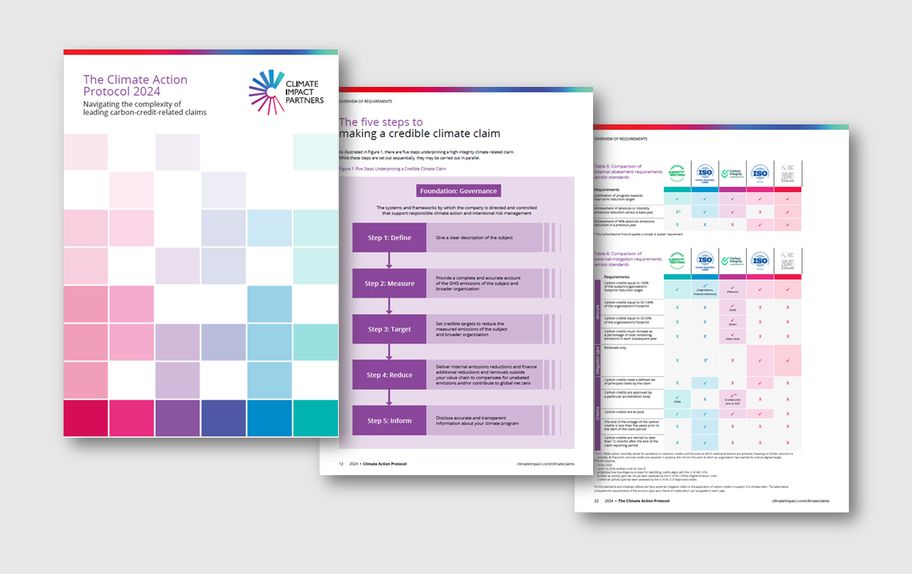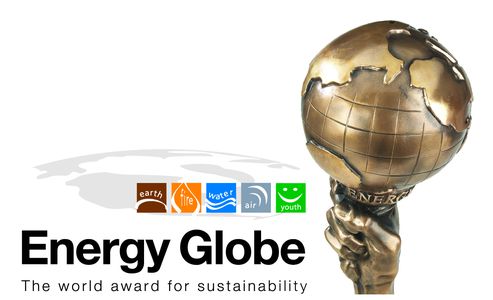Read our Climate Action Protocol to confidently navigate the complexities of making credible climate action claims.
Our latest paper helps businesses navigate the plethora of initiatives giving guidance on how companies using the voluntary carbon market can make climate claims with clarity and confidence.
Climate Action Protocol

We know this is a critical decade for the climate. In the next seven years, we must halve global emissions to keep global warming within 1.5 degrees Celsius and lower the risk of runaway climate change. We also know that government commitments alone will not get us there; companies have a critical role to play — supporting proven solutions that are already reducing and removing emissions.
For the past 25 years, the voluntary carbon market has enabled the corporate sector to participate in and fund projects which reduce, avoid, and remove carbon emissions. This funding has been provided on a voluntary basis – over and above any compliance requirements. The number of corporates that have made voluntary climate change commitments has grown from 23% in 2019 to 42% in 2022 based on research into the climate commitments of the Fortune Global 500.
The voluntary carbon market plays a critical role in the transformation to a global low carbon economy, bringing vital additional finance to reducing global emissions, while also channelling climate finance to communities often most impacted by, yet least responsible for, climate change. Recently there has been increased scrutiny of voluntary corporate action and the claims companies make to demonstrate their achievements or commitments. The fear of making the wrong claim and facing increasingly public accusations of greenwashing has meant that many companies are now reluctant to talk about their climate achievements, or to make climate claims, a phenomenon referred to as ‘greenhushing.’
There are currently a range of initiatives on-going to evolve and clarify how companies demonstrate their climate action through robust, transparent claims. These initiatives play a critical role in ensuring the voluntary carbon market delivers its full potential in meeting our global climate goals. However, in the interim, there is a complex landscape of options, each developing slightly different guidance and rules. Consequently, sustainability teams and those leading on climate strategies within companies are left with a patchwork of frameworks, opinions, and discussions to navigate.
Defining climate claims: carbon neutral vs net zero
Companies choose to integrate the use of carbon credits into their climate management strategies for many reasons, including being able to demonstrate to stakeholders that they are taking immediate and robust climate action.
They want to communicate this in a simple, credible, and meaningful way, making accurate claims for the action taken or commitment made, for example, carbon neutral or net zero. Claims provide the private sector with one incentive to go beyond their compliance requirements. Accurate claims need clear, comprehensible definitions and frameworks, but confusion remains around the definition of many widely used claims:
Carbon Neutral
Generally used to demonstrate that every tonne of CO2e, and other global warming gas emissions measured (of an entity, a product, or an activity) has been reduced by internal reductions, with the remainder offset by an equivalent number of carbon credits. Carbon neutrality is a type of compensation claim and is covered by a number of initiatives including The CarbonNeutral Protocol, the EU proposals, the French legislation, and ISO 14068.
Climate Neutral
This is a similar claim to carbon neutral, based on the same requirements, despite the broader wording of the claim which tends to be more popular in Europe.
Net Zero
Net zero was referenced in the Paris Agreement and has since become popular as a statement of intent for countries, companies, cities and others. It signifies when anthropogenic greenhouse gas emissions are balanced by greenhouse gas removals from the atmosphere, due to the finite budget of carbon dioxide that is allowed into the atmosphere if the rise of global average temperatures is to be limited. Typically, it is when the majority of emissions have been reduced following science-based pathways, with any remaining residual greenhouse gas emissions being fully compensated for by an equivalent amount of removals from the atmosphere.
Climate Positive
Other, less frequently used, corporate claims include climate positive, which has been defined as "reducing the greenhouse gas emissions from value chain in absolute terms in line with the 1.5°C target while contributing to additional reductions in society” by IKEA.
Carbon Positive
This claim has been used by housing company Berkeley Group to signify more carbon credits being purchased for offsetting than the total emissions of the entity, as well as more Renewable Energy Guarantees of Origin (REGOs) being purchased than their energy consumption.
Carbon Negative
This claim has been used by the brewery Brewdog, professional services firm EY, and technology company Microsoft to signify a similar action to that of carbon positive, in that more carbon credits are purchased for offsetting that the total emissions of the entity, although the type of credits used can vary. A similar claim to this is also climate negative.
Beyond Value Chain Mitigation
The Science Based Targets Initiative is currently developing guidance for companies going beyond their science-based emission reductions targets with additional climate finance for mitigation activities outside their value chains. This is likely to produce further corporate claims, as it is a suggested alternative to replace compensation claims, often known as offsetting, although the guidance has not yet been fully published.
Climate Mitigation Contribution
Following COP27 in November 2022 and the subsequent decisions on Article 6, the Paris Agreement’s mechanism for allowing countries to voluntarily cooperate with each other to achieve emission reduction targets, climate mitigation contributions have become a new concept. Some organizations have now proposed corporate claims following this approach, in a move away from compensation claims. The VCMI uses ‘contribution’ claims under its Silver, Gold, Platinum naming.
Climate Action Protocol
Read the Protocol to begin your voluntary climate action journey with confidence.
- Get more details about the claims
- Compare requirements
- Understand the next steps to make a credible claim of climate action.
The Latest Insights From
Climate Impact Partners

Making the Business Case for Climate Action: Insights from Sustainability Leaders
Making the Business Case for Climate Action: Insights from Sustainability Leaders with Kearney and Schroders
Read more
Beyond Carbon Credits: What the Proposed SBTi Net Zero Standard Updates Mean for Your Broader Climate Strategy
Climate Impact Partners has teamed up with Nature Positive to host a second session dedicated to unpacking the wider revisions proposed by the SBTi.
Read more
Pioneering Market Access: Climate Impact Partners' First K-REGO Transaction
Ricardo Hernandez shares his firsthand experience leading Climate Impact Partners' early entry into South Korea’s Energy Attribute Certificate (EAC) market.
Read more










